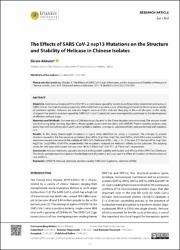| dc.contributor.author | Akbulut, Ekrem | |
| dc.date.accessioned | 2022-07-25T05:51:48Z | |
| dc.date.available | 2022-07-25T05:51:48Z | |
| dc.date.issued | 2022 | en_US |
| dc.identifier.citation | Akbulut, E. (2019). The Effects of SARS CoV-2 nsp13 Mutations on the Structure and Stability of Helicase in Chinese Isolates. European Journal of Biology. | en_US |
| dc.identifier.issn | 2602-2575 | en_US |
| dc.identifier.issn | 2618-6144 | en_US |
| dc.identifier.uri | https://doi.org/10.26650/EurJBiol.2022.1061858 | |
| dc.identifier.uri | https://hdl.handle.net/20.500.12899/1174 | |
| dc.description | Submitted: 23.01.2022, Revision Requested: 17.02.2022, Last Revision Received: 19.02.2022,
Accepted: 21.03.2022, Published Online: 13.04.2022. | en_US |
| dc.description | Content of this journal is licensed under a Creative Commons Attribution-NonCommercial 4.0 International License. | en_US |
| dc.description.abstract | Objective: Coronavirus Disease 2019 (COVID19) is a viral disease caused by Severe Acute Respiratory Syndrome Coronavirus-2 (SARS CoV-2). The high mutation propensity of the SARS CoV-2 genome is one of the biggest threats to the long-term validity of treatment options. Helicases are anti-viral targets because of the vital role they play in the viral life cycle. In this study, changes in the protein structure caused by SARS CoV-2 nsp13 mutations were investigated to contribute to the development of effective antiviral drugs. Materials and Methods: Genome data of 298 individuals located in the China location were examined. The mutant model was built using deep learning algorithms. Model quality assessment was done with QMEAN. Protein stability analyses were performed with DynaMut2 and Cutoff Scanning Matrix stability. Changes in substrate affinity were performed with Haddock v2.4. Results: In this study, twenty-eight mutations in nsp13 were identified (23 sense, 5 missense). The changes in protein structure caused by the five missense mutations (Leu14Phe, Arg15Ser, Arg21Ser, Leu235Phe, Ala454Thr) were modeled. The mutations caused a decrease in the stability of SARS CoV-2 helicase (-0.99, -1.66, -1.15, -0.54, and -0.73 for Leu14Phe, Arg15Ser, Arg21Ser, Leu235Phe, Ala454Thr, respectively). The mutations reduced the helicase's affinity to the substrate. The docking scores for wild-type and mutant helicase were -84.4±1.4 kcal.mol-1 and -71.1±6.7 kcal.mol-1, respectively. Conclusion: Helicase mutations caused a decrease in the protein stability and nucleic acid affinity of the SARS CoV-2 helicase. The results provide important data on the development of potential antivirals and the effect of mutation on the functions of viral proteins. | en_US |
| dc.language.iso | en | en_US |
| dc.publisher | İstanbul Üniversitesi / İstanbul University | en_US |
| dc.relation.ispartof | European Journal of Biology | en_US |
| dc.rights | info:eu-repo/semantics/openAccess | en_US |
| dc.subject | COVID19 | en_US |
| dc.subject | Helicase | en_US |
| dc.subject | Mutation | en_US |
| dc.subject | Protein stability | en_US |
| dc.subject | SARS CoV-2 genome | en_US |
| dc.subject | Substrate affinity | en_US |
| dc.subject.other | COVID-19 | en_US |
| dc.title | The Effects of SARS CoV-2 nsp13 Mutations on the Structure and Stability of Helicase in Chinese Isolates | en_US |
| dc.type | Article | en_US |
| dc.authorid | 0000-0002-7526-9835 | en_US |
| dc.department | MTÖ Üniversitesi, Mühendislik ve Doğa Bilimleri Fakültesi, Biyomühendislik Bölümü | en_US |
| dc.institutionauthor | Akbulut, Ekrem | |
| dc.identifier.doi | 10.26650/EurJBiol.2022.1061858 | |
| dc.identifier.volume | 81 | en_US |
| dc.identifier.issue | 1 | en_US |
| dc.identifier.startpage | 11 | en_US |
| dc.identifier.endpage | 17 | en_US |
| dc.relation.publicationcategory | Makale - Uluslararası Hakemli Dergi - Kurum Öğretim Elemanı | en_US |
| dc.identifier.scopus | 2-s2.0-85133881301 | en_US |
| dc.identifier.scopusquality | Q4 | en_US |
| dc.indekslendigikaynak | Scopus | en_US |


















